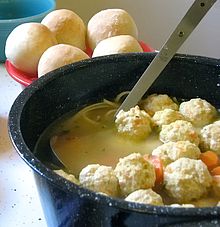Wedding Soup

A wedding soup is a clear soup based on a broth , from region to region enriched with combinations of chicken , meat balls , Markklossschen , liver dumplings , meat dumplings , Flädlestreifen , asparagus heads , pasta , croutons , Schöberl or egg custard , partly also be raisins added.
The wedding soup is traditionally consumed in northern and southern Germany by the wedding couple and guests after the wedding and usually forms the start of the menu at the wedding celebration . However, they are also available in other regions of Germany, as the bridal soup used to be part of every wedding celebration for all guests.
A well-known variant is the traditional Hadler wedding soup in the Land of Hadeln in northern Lower Saxony, which consists of a clear soup with beef, meatballs, rice, cauliflower and asparagus. For this, mares and often raisin bread served.
There are numerous recipes for wedding soups in regional cookbooks. Ready-made soups are also available commercially under this name.
The Turkish wedding soup is called Dügün Çorbasi and is also based on beef broth .
variants
In addition to the Hadler wedding soup from Lower Saxony's cuisine, various regional variants are known, such as:
- Altländer wedding soup . The variant is known in the Altes Land , a landscape in southern Hamburg and northern Lower Saxony. It is made from marrowbones with diced beef, leek, egg custard and raisins.
- Altmark wedding soup . Soup preparation of the Altmark in northern Saxony-Anhalt, on the basis of a fat chicken broth with a garnish of minced dumplings, egg dumplings and asparagus, partly also with celeriac, leek, carrots, diced chicken, egg dumplings and meatballs made from minced pork.
- Westphalian wedding soup . The variant common in Westphalia is traditionally made from beef ( soup meat ). It also forms the start of the wedding menu, followed by beef served cold with tartar sauce, pickled onions and pickles as the second course.
literature
- Ruth-E. Mohrmann : Bock beer, kale and wedding soup - Lower Saxony's culinary trademarks. In: Rheinisch-Westfälische Zeitschrift für Volkskunde , 54th volume, 2008, ISSN 0556-8218 , pp. 87-100.
- Tom Dieck: Pottkieker. 50 classic north German dishes with a history . Koehler, Hamburg 2013, ISBN 978-3-7822-1079-9 , pp. 42-43 .
Individual evidence
- ↑ a b Eckhard Supp : Duden. Dictionary culinary arts. From amuse-bouche to decorative snow . Dudenverlag, Mannheim a. a. 2011, ISBN 978-3-411-70392-0 , Chapter: Regional dishes in German-speaking countries , p. 82 .
